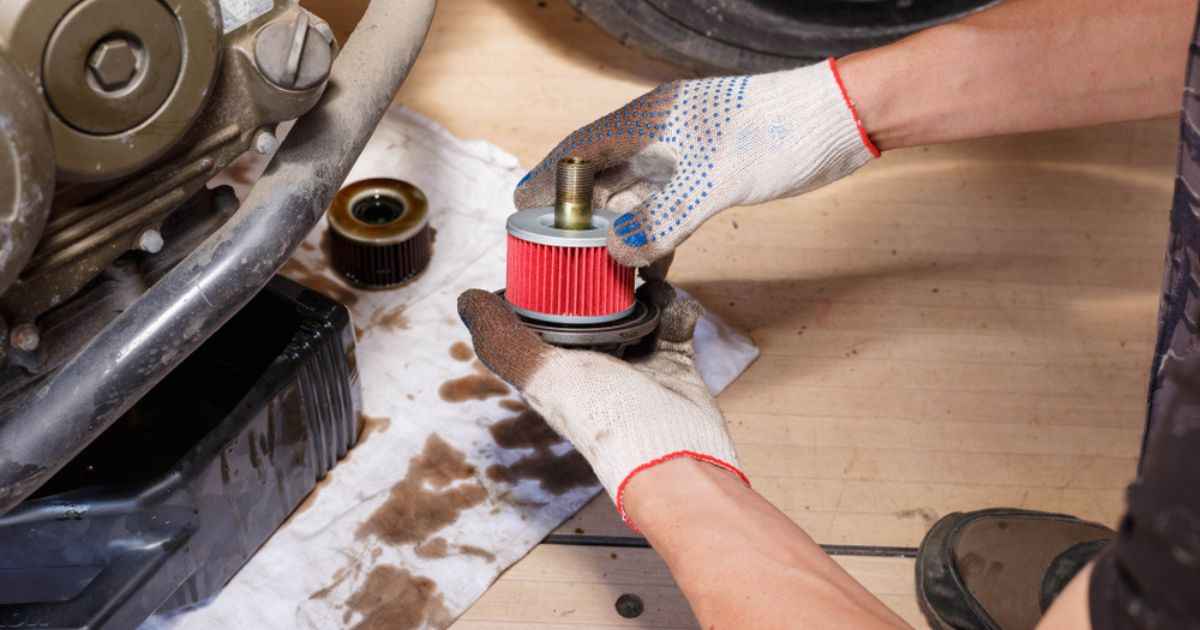Yes, most dirt bikes do have oil filters. Oil filters are crucial components in dirt bikes (as well as in other types of motorcycles) that help to remove contaminants and impurities from the engine oil, thereby ensuring smoother engine performance and longevity.
Both 2-stroke and 4-stroke dirt bikes typically use oil filters. Regular maintenance of the oil filter is essential to keep the dirt bike running smoothly and to prevent engine damage.
Some very old models, especially those built before the 1970s, might not have oil filters. Some specialized dirt bikes designed for competition, such as supermoto bikes, might have different lubrication systems that eliminate the need for a traditional oil filter.
What are the different types of oil filters used in dirt bikes?
Not all dirt bike oil filters are the same. Oil filters can vary in size, shape, material, and design depending on the specific make and model of the dirt bike.
There are several types, including spin-on filters, cartridge filters, magnetic filters, and centrifugal filters.
1. Spin-on Oil Filters:
- Most common type in modern dirt bikes.
- Self-contained housing and element screwed directly onto the engine.
- Easy to replace, typically requires just hand tools.
- Offer good filtration capacity and come in various performance levels.
2. Cartridge Oil Filters:
- Similar to spin-on filters, but only the filter element is replaced.
- Housing remains mounted on the engine.
- Can be slightly less convenient to change than spin-on filters.
- Often found on older dirt bikes or specific models.
3. Magnetic Oil Filters:
- Don’t replace traditional filters but work alongside them.
- Contain strong magnets that attract and trap ferrous metal particles.
- Can extend filter life and improve oil cleanliness.
- Not as effective against non-metallic contaminants.
4. Centrifugal Oil Filters:
- Less common, typically used in high-performance dirt bikes.
- Employ rapid rotation to separate contaminants from the oil.
- Offer efficient filtration but can be complex and expensive.
How often should I change the oil filter on my dirt bike, and what factors influence this?

Changing your dirt bike’s oil filter is crucial for a healthy engine and peak performance. But how often should you do it? Here’s a breakdown:
Manufacturer Recommendations:
Your owner’s manual! It provides expert recommendations based on your specific bike’s make, model, and engine characteristics. This is your golden rule!
Riding Conditions:
If you frequently ride in harsh conditions such as dusty or muddy terrains, or if you engage in high-performance riding, you may need to change the oil filter more often. These conditions can cause quicker contamination of the oil filter.
Oil and Filter are Partners:
Many riders change the filter whenever they change the oil. It’s a wise practice, as both work together to keep the engine clean.
Type of Oil Filter:
Some dirt bikes come with reusable oil filters, while others have disposable ones. Reusable filters need to be cleaned and inspected regularly, while disposable ones are replaced entirely during oil changes.
Can you change the oil filter yourself?
Yes, you can change your oil filter yourself. It’s one of the simplest and easiest car maintenance tasks. You can save money by changing your own oil filter, and you don’t need many tools.
Are there any specific tools needed to change a dirt bike oil filter?
Yes, there are a few specific tools you might need to change your dirt bike oil filter, depending on the type of filter your bike has and your own preference. Here’s a breakdown:
Basic tools:
- Socket wrench set: You’ll need sockets that fit the drain plug and (sometimes) the filter housing. Check your owner’s manual for specific sizes.
- Box wrench set: An alternative to the socket wrench, especially if you prefer hand tools.
- Oil filter wrench: This can be universal or specific to your bike’s filter type. Some filters might require a strap wrench or chain wrench if they’re particularly stubborn.
- Drain pan: To catch the old oil. Choose a size appropriate for your bike’s oil capacity.
- Funnel: For pouring new oil into the engine.
- Nitrile gloves: Protect your hands from oil and dirt.
- Rags: For wiping up spills and cleaning.
Always consult your owner’s manual for the specific tools and procedures recommended for your dirt bike model.
What are the consequences of not changing a dirt bike oil filter regularly?
Your dirt bike’s oil filter is like a superhero shield for its engine! But when it gets dirty, things can go downhill fast:
1. Filthy Filter, Grumpy Engine: Imagine your engine chugging dirty oil full of metal shavings and grit. That’s what happens with a clogged filter! These nasties cause friction, making your bike sluggish and robbing it of power.
2. Increased Engine Wear: The primary purpose of the oil filter is to remove contaminants from the engine oil, preventing them from causing damage to engine parts. When the filter becomes clogged or ineffective, these contaminants can circulate freely, causing increased friction and wear on critical engine components such as bearings, pistons, and cylinder walls.
3. Poor Engine Performance: Your bike might sputter and cough like it’s got a cold. Why? Dirty oil can’t lubricate properly, making everything move slower and less efficiently. It’s like trying to run in mud!
4. Risk of Engine Damage: Without proper filtration, abrasive particles and debris can cause damage to sensitive engine components. Over time, this can lead to costly repairs or even premature engine failure if left unaddressed.
Remember: A clean filter is a happy engine! Change it often and keep your dirt bike running strong and smooth for years to come.
Bonus Tip: Check your owner’s manual for specific oil change and filter replacement intervals based on your bike’s model and riding conditions.
Are there any performance benefits to using a higher-quality oil filter in a dirt bike?
Yes, there can be perfor mance benefits to using a higher-quality oil filter in a dirt bike. Here are some potential advantages:
Better filtration: Traps more contaminants, reducing wear and tear for smoother performance.
Higher efficiency: May flow oil better, minimizing power loss from restriction.
Longer life: Can last longer between changes, reducing maintenance costs.
Potential power gains: In high-performance bikes, cleaner oil can lead to slight power increases.
Peace of mind: Knowing you’re using the best protection for your engine.
Remember, benefits depend on your riding style and bike’s needs. Stick to manufacturer recommendations for most cases.

